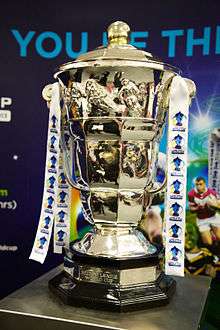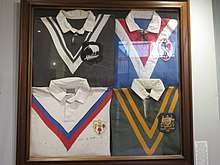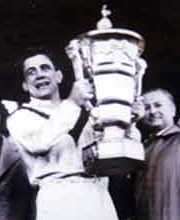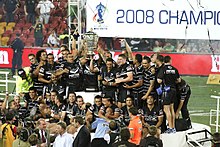Rugby League World Cup
The Rugby League World Cup is an international rugby league tournament, contested by national teams of the Rugby League International Federation, which was first held in France in 1954, the first World Cup in either rugby code.[1] The idea of a rugby league World Cup tournament was first mooted in the 1930s with the French proposal to hold a tournament in 1931, and again in 1951.[2] The fifteen tournaments held to date have been at intervals ranging from two to eight years, and have featured a number of formats.[3] So far three nations have won the competition (Australia eleven times, Great Britain three times and New Zealand once). Australia, France and New Zealand are the only teams to have played in all tournaments (Great Britain has been split into England, Wales, Scotland and Ireland since 1995, while England and Wales had previously competed as separate teams in the 1975 World Cup). Since 2000, the RLIF has also organised World Cups for women, students and other categories. The 2017 Rugby League World Cup was held in Australia, New Zealand and Papua New Guinea which was won by Australia.[4]
| Current season or competition: | |
 | |
| Sport | Rugby league |
|---|---|
| Instituted | 1954 |
| Number of teams | 16 (from 2021) |
| Region | International (RLIF) |
| Holders | |
| Most titles | |
| Website | www.rlwc2021.com/ |
| Related competition | Women's World Cup World Cup 9s |
| Tournaments | |
|---|---|
History
1935–1954: Establishment


The Rugby League World Cup was an initiative of the French who had been campaigning for a competition since 1935. The idea was raised in 1951 by Paul Barrière, the President of the French Rugby League. In 1952, Rugby Football League secretary Bill Fallowfield persuaded the Rugby League Council to support the concept.[5] At a meeting in Blackpool, England in 1953, the International Board accepted Paul Barrière’s proposal that France should be the nation to host[5] the first tournament to be officially known as the "Rugby World Cup".[6] In addition to the hosts, the tournament featured teams from Britain, Australia and New Zealand.[7] The 1954 Rugby League World Cup was won by Great Britain who defeated France in Paris on 13 November to claim the title.
1955–1974: Sporadic competitions
The World Cup was initially contested by the four Test nations: Australia, Great Britain, France and New Zealand. The teams played each other in a league format. A final match was played between the top two teams in 1954. It was then decided that the team that finished first in the league would be declared the winner at the second World Cup in 1957, when Australia proved victorious on their home ground.
After the successful 1960 competition, in which Great Britain won the title for the second time, there would be no further World Cup for eight years. The competition had been scheduled to be held in France in 1965, this time with the inclusion of the South African team.[8] However, after an unsuccessful tour of Australia, the French withdrew. The tournament was next held in 1968, and followed a two-year cycle until the mid-1970s.
The 1972 World Cup final ended 10-all, and the title was awarded to Great Britain by virtue of their superior record in the qualifiers. Great Britain were captained by Welshman, Clive Sullivan who was the first black player to captain any British national sports team.
1975–1990s: No host nations
In 1975, the competition underwent a radical overhaul. It was decided to play matches on a home and away basis around the world instead of one host nation and the Great Britain team was split into England and Wales meaning that the tournament would be increased from the 4 teams of previous tournaments to 5, this number also taking part in the two future internationally held tournaments. There was not a final held to decide the champions of the 1975 tournament and so Australia won by virtue of topping the group standings. As Australia had not beaten England in that tournament a 'final challenge match' was hastily arranged which Australia would win 25-0.
In 1977 it was decided that Great Britain should once more compete as a single entity. Although the final between Australia and Great Britain was a closely fought affair, public interest in the tournament waned due to the continuing tinkering with the format and it was not held again until the mid-1980s.
From 1985 to 1988, each nation played each other a number of times on a home and away basis with a number of these games also being considered part of various international tours that took place during the years in which these world cups were being played. At the end of that period, Australia met New Zealand at Eden Park. The match was a physical encounter, and Australian captain Wally Lewis played part of the match with a broken arm. The Kangaroos won the competition 25-12 in front of a capacity crowd of nearly 48,000 spectators.
This format was repeated from 1989–1992 (with games once again also being part of tours) and Australia won again, defeating Great Britain 10-6 at Wembley Stadium in front of 73,361 people. This crowd remained a Rugby League World Cup record (and a record for any rugby league international match) until beaten by the 74,468 crowd which attended the 2013 World Cup Final at Old Trafford.[9] The fifth nation to compete in these two tournaments was Papua New Guinea, where rugby league is the national, and most popular, sport.
1995–2008: Knockout tournament and expansion

In 1995, the competition was once again restructured, returning to the traditional 'host' format with ten teams entering. Unlike previous tournaments where the top two teams in the table playing in the final, a knockout stage was added with a quarter and semi final. New teams competing included Fiji, Tonga, Samoa and South Africa. Due to the Super League war, players aligned with the rebel competition were not selected by the ARL to represent the Kangaroos. This meant the absence of many star players from the Australian team's line-up. The tournament, which was also held to celebrate the centenary of the sport in England, was highly successful with over 250,000 people attending the group stages and over 66,000 people attending the final to see Australia defeat England 16-8.
Following the Super League war, the subsequent re-structuring of rugby league's international governing bodies meant that the proposed 1998 World Cup was postponed.[10]
The 2000 World Cup expanded the field further, with sixteen teams entering. This tournament included a New Zealand Maori representative team, the only time this team has taken part. However numerous issues including poor organization and blown-out scorelines meant that this tournament was seen as highly unsuccessful with an average attendance just half that of the previous tournament. Due to these problems the competition was put on indefinite hiatus. Australia won the tournament by beating New Zealand 40-12 in the final at Old Trafford, Manchester. In the same year, the first Women's Rugby League World Cup was held with New Zealand defeating Great Britain.
The World Cup returned in 2008 with a 10-team format. Australia hosted the tournament and New Zealand were crowned champions for the first time by beating the host nation at Lang Park, Brisbane. The world cup was once again seen as a success with a 91% average attendance increase on the previous competition. New Zealand became only the third team to win the world cup and the first other than Australia since 1972.
2009–present: Regular competition
The 2013 tournament, hosted by England and Wales, expanded to 14 teams and was considered the most successful competition to date in terms of attendances, exposure and financial output. Australia took the title again after defeating New Zealand in the final by a score of 34–2. The final attendance became the record international rugby league attendance at 74,468.
Following the 2013 tournament, it was decided that the world cup would be scheduled to take place every four years, 2017 Rugby League World Cup taking place in Australia, New Zealand and for the first time in Papua New Guinea. While Australia would claim the title once again and for an eleventh time, the tournament was considered highly successful in terms of competitiveness. The tournament would see Tonga beat New Zealand in the group stages with a score of 28-22 to top the group, the first time a team from outside the top 3 had beaten a top 3 nation in over two decades. New Zealand went on to play Fiji in the quarter-finals and lost once again with a score of just 4-2, knocking New Zealand out in the quarter-finals, the first time a tier 1 nation had exited the tournament at this early stage. Tonga played England in the semi-finals and while conceding 20 unanswered points, they would score 3 tries in just the last seven minutes to pull the score back to 20-18, eventually losing by this close margin. The final was contested between Australia and England at Lang Park, Brisbane and Australia won by just 6-0, the lowest score in world cup final history.[11]
The 2021 tournament will be held in England with organisers expressing a desire to see a total of one million fans attend games. This tournament will see the number of teams increased to 16 once again. The 2025 Rugby League World Cup will be held in the United States and Canada.[12]
Trophy

The World Cup trophy was commissioned by French Fédération Française de Rugby à XIII president Paul Barrière at a cost of eight million francs, and then donated to the International Rugby League Board to be used for the inaugural competition in 1954.[13] This trophy was used and presented to the winning nation for the first four tournaments, before being stolen in 1970. After its recovery, the trophy was reinstated for the 2000 tournament.
Format
Qualification
Australia, France and New Zealand are the only nations who have appeared at every Rugby League World Cup from 1954 to 2017. England has also been at all, but participated under the banner of Great Britain in the majority of the earlier tournaments. Wales, including as Great Britain, has competed in all but the 2008 tournament.
In total, 19 teams have taken part in the world cup. While 18 of these represented nations, 1 did not; in 2000, the Aotearoa Māori team was granted entry to the competition. This team is made up of New Zealand Māori players and was knocked out of the world cup in the pool stage. Only one other team has taken part in just a single world cup; Russia. In total 29 teams have/will taken part in qualifying rounds while 5 other teams have always been granted automatic qualification, meaning 34 teams have taken part in some stage of the world cup.
Qualifying rounds were first introduced for the 2000 World Cup. Rounds take the form of groups of teams from specific continents/regions; Europe, Africa/middle-east, Asia/pacific and the Americas. Teams that automatically qualify are the quarter-finalists from the previous world cup.
Qualifying for the 2021 World Cup will feature 20 teams, the most to date with 8 teams having automatically qualified. 13 of these teams have never qualified for the world cup with the possibility of 7 of these debutants to reach the tournament proper. 14 teams will take part in the European stage of the qualifying with 4 teams in the Americas group and 3 in the world play-offs where the runner-up of the Americas group will meet the highest ranked teams from Asia/pacific and Africa/middle-east.
Finals
The Rugby League World Cup has followed a varied range of formats throughout its history as the number of teams participating has increased.
The current format has been in use since 2013 featuring 14 teams split into two groups of four and two groups of three. Three teams from the groups of four qualify for the knockout stage and one team from the groups of three qualify. Each team is awarded two points for a win and one point for a draw.
The eight teams in the quarter finals play each other with the four winners progressing to the semi finals before the World Cup Final. If the teams are level after 80 minutes extra time will be played and if the two teams are still level after extra time, a golden point will be played.
In 2017 the final tournament followed the same format as that of 2013 but this will change for 2021 when the number of teams taking part is increased to 16.
| Year | Teams | Format |
|---|---|---|
| Round Robin era | ||
| 1954 | 4 |
|
| 1957 |
| |
| 1960 | ||
| 1968 |
| |
| 1970 | ||
| 1972 | ||
| 1975 | 5 | |
| 1977 | 4 | |
| 1985–1988 | 5 | |
| 1989–1992 | ||
| Groups and Knockout era | ||
| 1995 | 10 |
|
| 2000 | 16 |
|
| 2008 | 10 |
|
| 2013 | 14 |
|
| 2017 | ||
| 2021 | 16 |
|
Hosts
Eight teams have officially hosted and co-hosted the World Cup. Only 1975, 1985-88 and 1989-92 were held internationally and not in a specific country. Scotland hosted games in the 2000 world cup but these games were considered to have been hosted by Great Britain rather than the specific home nations. Although games were played in Papua New Guinea during the 1985–88 and 1989-92 World Cups, they are due to officially become the eighth nation to host games in 2017 alongside Australia and New Zealand.
| Host | Count | Years |
|---|---|---|
| 6 | 1969, 1970, 1995, 2000, 2013, 2021 | |
| 5 | 1957, 1968, 1977, 2008, 2017 | |
| 4 | 1954, 1972, 2000, 2013 | |
| 3 | 1968, 1977, 2017 | |
| 2 | 2000, 2013 | |
| 2 | 2000, 2013 | |
| 1 | 2000 | |
| 1 | 2017 | |
- Bold: co-hosted tournaments
Stadiums
In total, 81 stadiums have hosted world cup games over the 14 tournaments. Headingley Stadium in Leeds has hosted the tournament the most times, having had games in 7 world cups with Central Park, Wigan and Lang Park, Brisbane having hosted 6 tournaments. 52 stadiums have hosted matches in just 1 tournament. The most stadiums used in a tournament was in 2000 when 26 stadiums were used; the stadium capacity was the highest ever at 704,400. However, the occupancy was also the lowest ever at just 37.46%.
The largest stadium in terms of capacity ever used was Wembley Stadium, London with a seating capacity of 90,000; the stadium was used in the 2013 tournament as the venue for the semi-final double-header. The smallest stadium ever used was also in 2013 when The Gnoll, Neath, with a capacity of 5,000 hosted a game between Wales and Cook Islands. Despite this, it was not the lowest attended game; this was in the 2000 world cup when just 1,497 attended the game between Wales and Lebanon at Stradey Park, Llanelli.
The city with the most stadiums used is Sydney with 4. Hull and Auckland are the cities with the next highest number with 3 each.
| Rank | Country | Stadiums |
|---|---|---|
| 1 | 33 | |
| 2 | 21 | |
| 3 | 13 | |
| 4 | 7 | |
| 5 | 6 | |
| 6 | 3 | |
| 7 | 2 | |
| 2 |
Results
Results by year
* Highest ranked team during Round Robin round won World Cup
× 'Final' Challenge Match played, as Australia won the 1975 World Cup (decided by ranking in Round Robin round) without having beaten England.
Results by team
Up to and including the 2017 tournament, only Australia, New Zealand and Great Britain had been crowned World Champions. Australia has been by far the most successful, finishing in the top three in all 15 tournaments and winning 11. Great Britain have won three times, and New Zealand once. New Zealand have also finished runners-up in three World Cups, while France have been runners-up twice, including the inaugural cup where they were captained by Puig Aubert. England have also finished runners-up three times, while the Great Britain team were runners-up four times. Fiji have reached the semi-finals three times, while Wales also made the semi-final in 1995 and 2000. Ireland and Samoa have twice made it past the qualifying pool stages. Other nations to have proceeded to the knock-out stages are Papua New Guinea, Scotland, the United States, and Lebanon.
| Team | Champions | Runners-up | Semi-finals | Quarter-finals |
|---|---|---|---|---|
| 11 (List) | 3 (1960, 1972, 2008) | – | – | |
| 3 (1954, 1960, 1972) | 4 (1957, 1970, 1977, 1989–92) | – | – | |
| 1 (2008) | 3 (1985–88, 2000, 2013) | 1 (1995) | 1 (2017) | |
| – | 3 (1975, 1995, 2017) | 3 (2000, 2008, 2013) | – | |
| – | 2 (1954, 1968) | – | 2 (2000, 2013) | |
| – | – | 3 (2008, 2013, 2017) | – | |
| – | – | 2 (1995, 2000) | – | |
| – | – | 1 (2017) | – | |
| – | – | – | 3 (2000, 2013, 2017) | |
| – | – | – | 2 (2000, 2008) | |
| – | – | – | 2 (2000, 2017) | |
| – | – | – | 1 (2013) | |
| – | – | – | 1 (2013) | |
| – | – | – | 1 (2017) |
- Tournaments between 1954–1992 did not feature semi-final and quarter-final rounds.
Attendance
Tournament attendance
| Year | Matches | Avg attendance | Total attendance | % change in average attendance | Stadium capacity (%) | Host(s) |
|---|---|---|---|---|---|---|
| 1954 | 7 | 19,761 | 138,329 | N/A | 285,100 (48.51%) | |
| 1957 | 6 | 35,820 | 214,918 | 370,000 (58.08%) | ||
| 1960 | 6 | 18,376 | 110,200 | 217,000 (50.78%) | ||
| 1968 | 7 | 31,562 | 220,683 | 350,000 (63.05%) | ||
| 1970 | 7 | 9,816 | 68,710 | 181,200 (37.91%) | ||
| 1972 | 7 | 8,922 | 62,456 | 222,700 (28.04%) | ||
| 1975 | 21 | 9,737 | 204,476 | 294,500 (69.43%) | ||
| 1977 | 7 | 15,670 | 109,688 | 274,000 (40.03%) | ||
| 1985–88 | 18 | 12,125 | 218,246 | 456,000 (47.86%) | ||
| 1989–92 | 21 | 14,289 | 300,059 | 521,500 (57.57%) | ||
| 1995 | 15 | 17,707 | 265,609 | 413,300 (64.26%) | ||
| 2000 | 31 | 8,514 | 263,921 | 704,400 (37.46%) | ||
| 2008 | 18 | 16,302 | 293,442 | 533,800 (54.97%) | ||
| 2013 | 28 | 16,374 | 458,483 | 573,200 (79.98%) | ||
| 2017 | 28 | 13,338 | 373,461 | 750,700 (49.75%) | ||
| 2021 | 31 |
Match attendance
Top 10 match attendances.
| Year | Venue | City | Event | Attendance |
|---|---|---|---|---|
| 2013 | Old Trafford | Final | 74,468 | |
| 1989-92 | 'Old' Wembley Stadium | Final | 73,631 | |
| 2013 | Wembley Stadium | Semi Final (double header) | 67,575 | |
| 1995 | 'Old' Wembley Stadium | Final | 66,540 | |
| 1968 | Sydney Cricket Ground | Group Stage | 62,256 | |
| 1957 | Sydney Cricket Ground | Group Stage | 58,655 | |
| 1968 | Sydney Cricket Ground | Final | 54,290 | |
| 2008 | Lang Park | Final | 50,599 | |
| 1957 | Sydney Cricket Ground | Group Stage | 50,077 | |
| 1985-88 | Eden Park | Final | 47,363 | |
See also
- List of international rugby league teams
- Mediterranean Cup
- Pacific Cup
- RLIF World Rankings
- Rugby League Asian Cup
- Rugby League European Cup
- Rugby League Four Nations
- Rugby League World Cup records
- Tertiary Student Rugby League World Cup
- Women's Rugby League World Cup
References
Inline
- Folkard, 2003: 337
- Richard William Cox; Wray Vamplew; Grant Jarvie (2000). Encyclopedia of British Sport. UK: ABC-CLIO. p. 426.
- McCann, Liam (2006). Rugby: Facts, Figures and Fun. UK: AAPPL Artists' and Photographers' Press. p. 80.
- Fletcher, Paul. "Rugby League World Cup 2013: New Zealand 2-34 Australia". BBC Sport. Retrieved 1 December 2013.
- Waddingham, Steve (2008-06-14). "Why this trophy for winning the rugby league World Cup?". The Courier-Mail. Brisbane. Archived from the original on 2010-01-10. Retrieved 10 January 2010.
- SPARC, 2009: 28
- AAP (1953-01-19). "World Cup Suggestion". The Sydney Morning Herald. Australia. p. 7. Retrieved 2009-12-25.
- AAP; Reuter (1962-08-15). "League Cup Year Fixed". The Sydney Morning Herald. Auckland. p. 18. Archived from the original on 2013-01-03. Retrieved 2009-10-06.
- AAP (1 December 2013). "Record rugby league crowd for World Cup final". stuff.co.nz. Retrieved 1 December 2013.
- John Coffey; Bernie Wood (2008). 100 years: Māori rugby league, 1908-2008. Huia Publishers. p. 302. ISBN 9781869693312.
- "Australia 6 England 0". BBC Sport. 2 December 2017. Retrieved 13 December 2017.
- Fletcher, Paul. "Rugby League World Cup: North America set to host 2025 tournament". BBC Sport. Retrieved 21 November 2016.
- RLIF. "Past Winners: 1954". Rugby League International Federation. Archived from the original on 2008-10-12. Retrieved 2008-10-25.
- "Papua New Guinea to co-host Rugby League World Cup in 2017". Australian Broadcasting Corporation. Australian Associated Press. 8 October 2015. Retrieved 8 October 2015.
General
- Folkard, Claire (2003). Guinness World Records 2003. Bantam Books. ISBN 9780553586367.
- McCann, Liam (2006). Rugby: Facts, Figures and Fun. AAPPL. ISBN 9781904332541.
- Independent Review Committee (February 2009). "Rugby League - Contributing to New Zealand's Future" (PDF). New Zealand: SPARC. Archived from the original (PDF) on 2010-10-01. Retrieved 13 December 2009.
- Rleague.com (February 23, 2010). "20 TEAMS TO VIE FOR WORLD CUP GLORY IN 2013". [International Rugby League]. Archived from the original on March 5, 2010. Retrieved February 23, 2010.
External links
| Wikimedia Commons has media related to Rugby League World Cup. |
- Official Rugby League World Cup Website
- Rugby League International Federation
- BBC website, History (1954–2000) retrieved 2 May 2006
- "RLIF Meeting", 2008 World Cup European Rugby League Federation, retrieved May 8, 2006
- "Kiwi hangover after the hype", 2013 World Cup retrieved 8 May 2006
- Rugby League World Cup at napit.co.uk
Further reading
- Andrews, Malcolm & Butcher, Tim (2009). The Rugby League World Cup. League Publications.